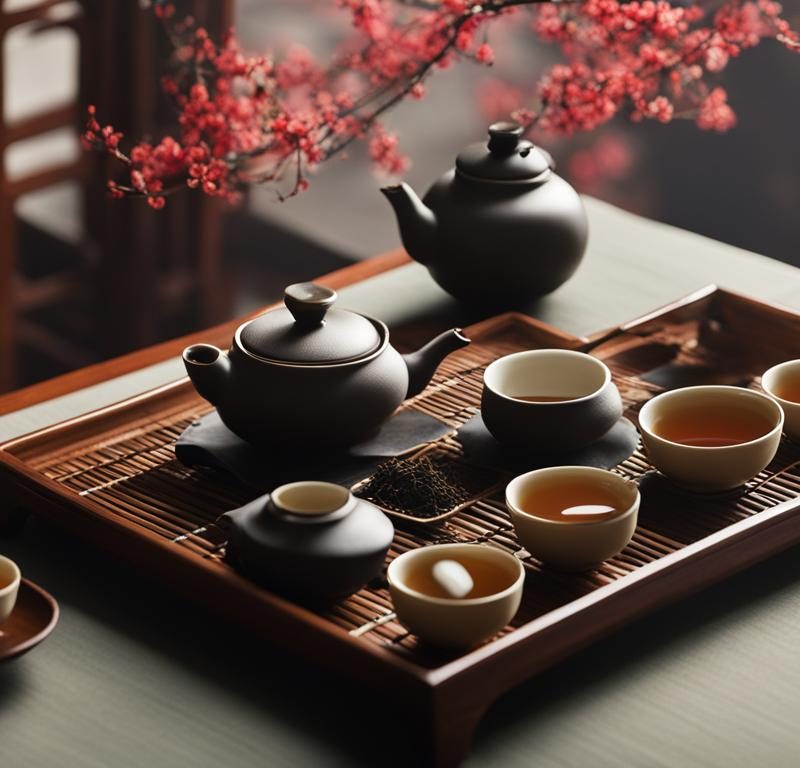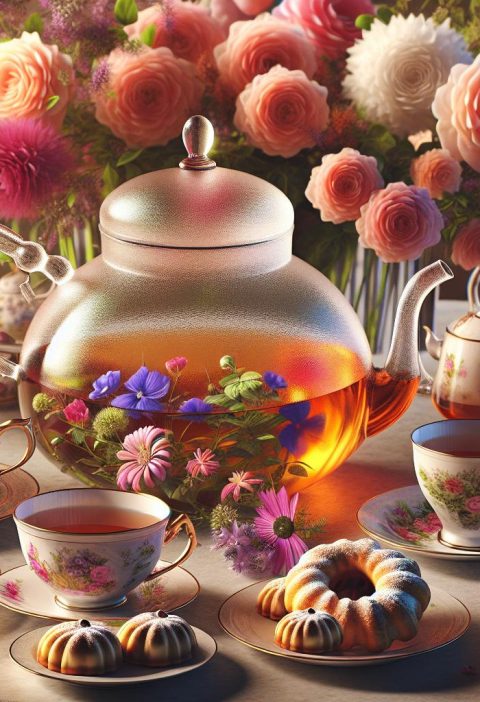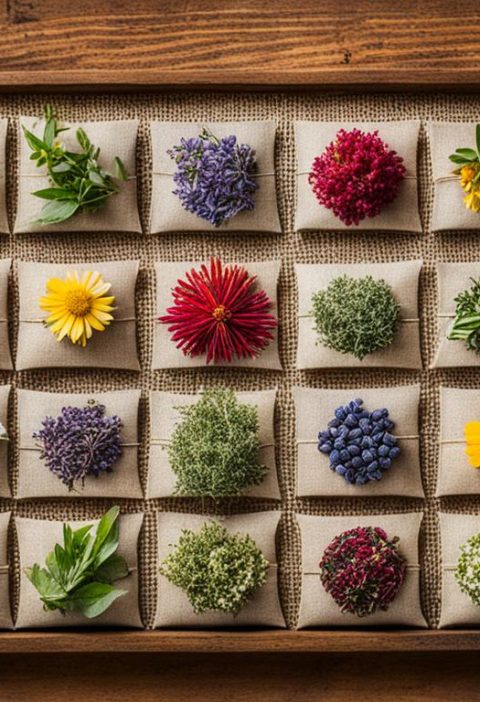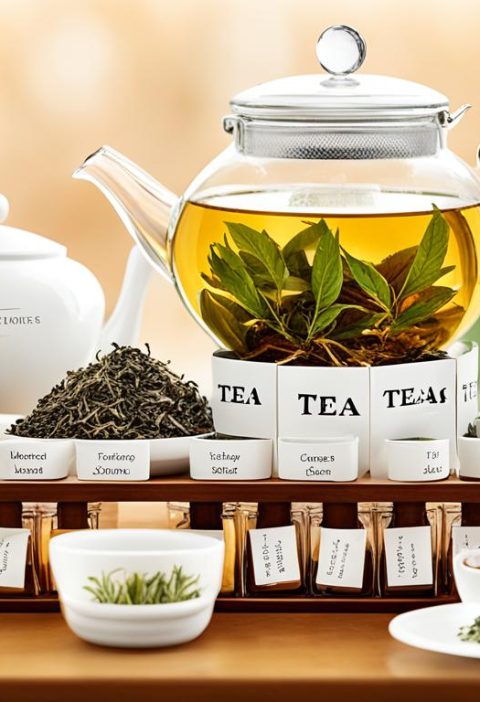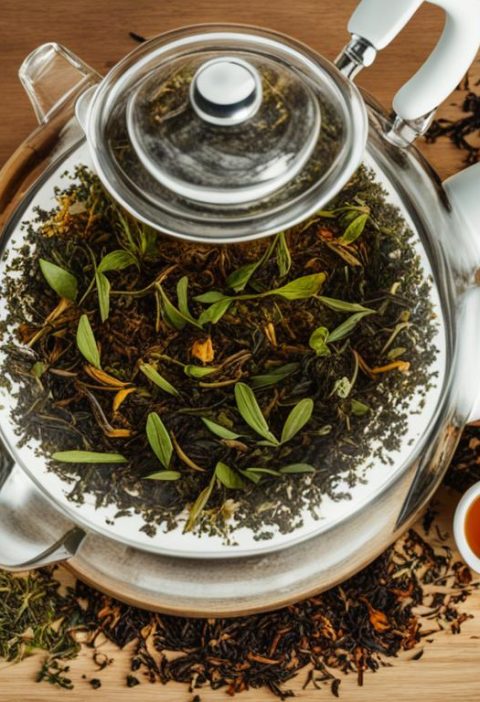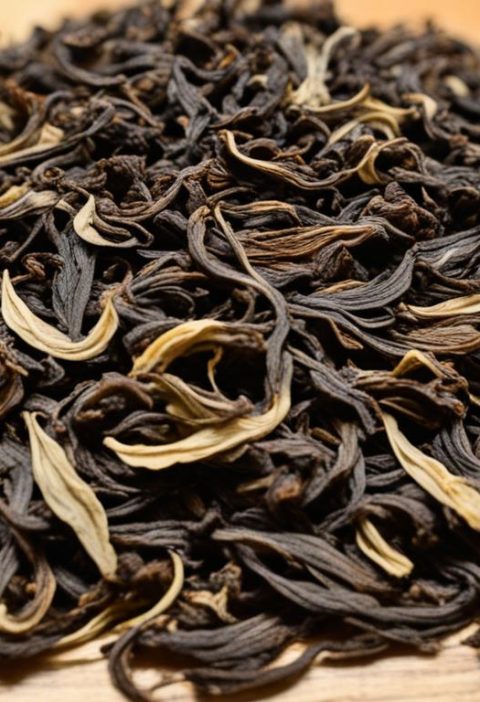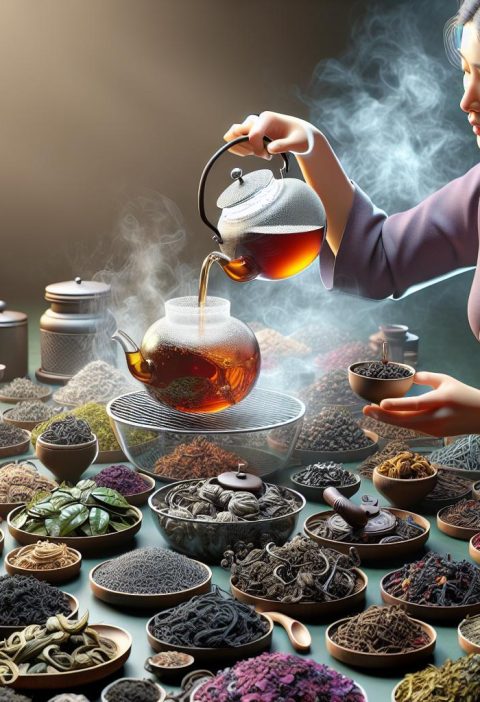From the early days of ancient China, the art of brewing tea has become a global practice with diverse cultural nuances. Tea brewing methods vary depending on the type of tea and the desired flavors. This article will provide a comprehensive guide on brewing techniques for aromatic teas, covering various types of tea, recommended brewing equipment, infusion techniques, and steeping times.
As a passionate tea enthusiast, I have spent years experimenting with different brewing techniques to unlock the full potential of aromatic teas. Through my experience and research, I have discovered the nuances that make each type of tea unique and how brewing methods can enhance their flavors and aromas. In this article, I will share my insights and expertise to help you master the art of brewing aromatic teas.
Key Takeaways
- Understanding the origins of tea and its brewing traditions helps deepen the appreciation for the art of tea brewing.
- Each type of tea requires specific brewing parameters, such as water temperature and steeping time, to achieve the perfect cup.
- Investing in high-quality tea and brewing equipment can greatly enhance the overall tea brewing experience.
- Exploring different tea brewing techniques from around the world opens up a world of flavors and rituals to enjoy.
- Personal experimentation and preference play a significant role in finding your perfect cup of aromatic tea.
The Origins of Tea and Brewing
Tea has a rich history that dates back to ancient China. According to Chinese folklore, tea was discovered by Emperor Shen Nong in 2737 BCE. From there, tea cultivation and brewing methods spread to different cultures and countries, each contributing their own unique brewing techniques and rituals. The Chinese tea ceremony, Japanese tea ceremonies, and British afternoon tea are examples of cultural traditions that have shaped the art of tea brewing.
The discovery of tea by Emperor Shen Nong marked the beginning of a beverage that would captivate many civilizations over thousands of years. Legend has it that while Emperor Shen Nong was resting under a Camellia sinensis tree, a leaf fell into his cup of hot water, resulting in a delicious and fragrant concoction that we now know as tea. This fortunate accident set in motion a discovery that would leave an indelible mark on human history.
As tea became popular in China, it also found its way beyond its borders. Buddhist monks played a significant role in spreading the cultivation and brewing techniques of tea to Japan in the 9th century, where it became an integral part of Zen Buddhism and Japanese tea ceremonies. In medieval Europe, tea was introduced by Portuguese and Dutch traders, eventually becoming a staple of the British social and cultural tradition.
The Chinese tea ceremony, known as “gongfu cha,” holds a special place in the history of tea brewing. It is a ritualistic and elaborate practice that involves precise measurements, infusion techniques, and the artful presentation of tea. Gongfu cha celebrates the beauty and essence of tea, creating a sensory experience for both the brewer and the drinker.
A similar reverence for tea is found in Japanese tea ceremonies, which emphasize mindfulness, tranquility, and the appreciation of the moment. The intricate choreography, the delicate selection of tea utensils, and the graceful movements of the tea master create an atmosphere of harmony and contemplation.
British afternoon tea, on the other hand, is a more relaxed and social affair. It traditionally involves enjoying a cup of tea with an assortment of pastries, sandwiches, and scones. The ritual of afternoon tea became popular during the 19th century in England and remains a cherished tradition today.
Throughout history, different cultures have developed their own unique tea brewing rituals and traditions, each adding to the tapestry of tea’s global heritage. From the elaborate ceremonies of China and Japan to the casual gatherings of friends over a cup of tea, the art of tea brewing continues to captivate tea lovers all over the world.
Chinese Tea Ceremony
The Chinese tea ceremony, also known as gongfu cha, is a time-honored practice that involves precise brewing methods and a deep appreciation for the beauty of tea. The ceremony showcases the elegance and grace of tea brewing, often accompanied by artful tea utensils and traditional tea sets.
Japanese Tea Ceremonies
Japanese tea ceremonies, or chanoyu, embody the principles of harmony, respect, purity, and tranquility. The ceremony is a ritualistic experience that emphasizes mindfulness and the artful preparation and serving of matcha tea.
British Afternoon Tea
British afternoon tea is a beloved tradition that involves enjoying a cup of tea accompanied by a selection of pastries, sandwiches, and scones. It is a social occasion that brings people together and provides an opportunity to savor tea in a leisurely and elegant setting.
Brewing the Perfect Cup of Black Tea
Black tea is known for its robust flavor and dark color, making it a popular choice among tea enthusiasts. To brew the perfect cup of black tea, follow these simple steps:
1. Choose High-Quality Loose Leaf Black Tea
To ensure a rich and flavorful brew, opt for high-quality loose leaf black tea. Loose leaf tea allows the leaves to fully expand and release their flavors, resulting in a more enjoyable tea experience.
2. Use the Right Water Temperature
The water temperature plays a crucial role in extracting the optimal flavors from black tea. Heat the water to around 200-212°F (93-100°C). This temperature range allows the tea leaves to infuse properly without scorching or under-extracting.
3. Steeping Time Matters
The steeping time determines the strength and intensity of the black tea. Generally, steep black tea for 3-5 minutes. Adjust the steeping time based on personal preference for a stronger or milder brew. Keep in mind that steeping the tea for too long may result in bitterness.
4. Enhance Your Brewing Experience
Investing in the right tea brewing equipment can elevate your tea brewing process. Consider using a teapot with an infuser or a tea ball infuser to keep the loose leaf tea contained during steeping. This ensures easy extraction and minimal mess.
Follow these steps, and you’ll be able to enjoy a perfectly brewed cup of black tea, bursting with robust flavors and enticing aromas.
Getting a Great Green Tea Experience
Green tea is celebrated for its grassy notes and health benefits. To fully enjoy the flavors and benefits of green tea, it is essential to master the art of green tea brewing. Here, we will explore the key elements of brewing the perfect cup of green tea: the water temperature, steeping time, and the use of loose leaf tea.
Water Temperature for Green Tea
When it comes to green tea, the water temperature plays a crucial role in ensuring optimal flavor extraction and preventing any bitterness. It is recommended to use water heated to a lower temperature, around 160-185°F (71-85°C). This gentle heat preserves the delicate flavors of the green tea leaves, allowing the subtle grassy notes to shine.
Steeping Time for Green Tea
Green tea is delicate and can become bitter if steeped for too long. The recommended steeping time for green tea is 2-3 minutes. This short steeping time allows the flavors to infuse into the water without overpowering the cup with bitterness. However, personal preference may vary, and some individuals may prefer a stronger brew by extending the steeping time.
Loose Leaf Green Tea
Using high-quality loose leaf green tea is key to experiencing the full range of flavors green tea has to offer. Loose leaf teas generally provide a fresher and more complex taste compared to tea bags. The leaves have more room to expand and release their flavors, resulting in a more aromatic and enjoyable cup of tea.
| Water Temperature | Steeping Time | Loose Leaf Tea |
|---|---|---|
| 160-185°F (71-85°C) | 2-3 minutes | High-quality loose leaf green tea |
Making the Most out of Your Matcha
Matcha tea is a unique and revered tea that requires a special brewing method to unlock its full flavor and vibrancy. Whether you’re preparing matcha for a traditional Japanese matcha ceremony or simply enjoying a cup at home, these tips will help you make the most out of your matcha experience.
When it comes to matcha tea brewing, quality matcha powder and specialized matcha equipment are key. Follow these steps to prepare matcha tea:
- Sift the matcha powder: Start by sifting one to two teaspoons of matcha powder into a matcha bowl. This step helps to break up any clumps and ensures a smooth and even infusion.
- Add hot water: Gradually pour hot water, heated to around 160-180°F (71-82°C), over the matcha powder in the bowl. The water should not be boiling to preserve the delicate flavors of the matcha.
- Whisk it vigorously: Using a bamboo whisk, whisk the matcha tea vigorously in a “W” or “M” motion until a frothy layer forms on the surface. This process is essential for creating a velvety, emerald-green infusion.
- Enjoy your matcha: Once your matcha tea is prepared, take a moment to appreciate its vibrant color and aromatic scent. Savor each sip and experience the unique flavor profile that matcha offers.
Specialized matcha equipment, such as a matcha bowl (chawan) and bamboo whisk (chasen), are integral to the matcha brewing process. These tools enhance the ritualistic nature of matcha preparation and contribute to the overall sensory experience.
Embrace the tradition and artistry of matcha tea brewing with these tips and elevate your tea rituals with the rich flavors and vibrant green hues of this beloved tea.
Brewing White Loose-Leaf Tea
White tea is a delicately flavored and aromatic beverage cherished by tea enthusiasts. To fully savor its nuances, it’s essential to employ the correct brewing technique. When preparing white tea, avoid using boiling water directly on the delicate leaves, as it can result in a bitter brew. Instead, opt for warm water with temperatures ranging from 160-185°F (71-85°C). This lower temperature allows the tea to unfurl and release its exquisite flavors without any harsh notes.
Steeping time is another crucial factor in achieving the perfect cup of white tea. Longer steeping times of 4-5 minutes are recommended to allow the flavors to fully develop. This extra time allows the delicate flavors and floral aromas to infuse into the water, creating a harmonious balance of taste and fragrance.
For a visually appealing experience, brewing white tea in a gaiwan or glass teacup is highly recommended. These vessels allow you to witness the mesmerizing unfurling of the tea leaves, resembling a delicate dance in your cup.
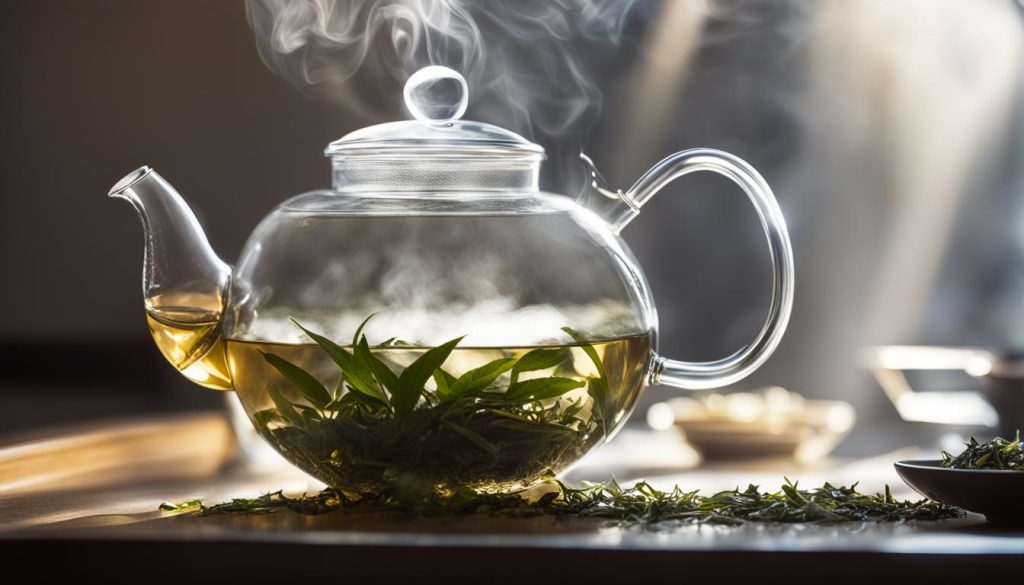
Tips for Brewing White Loose-Leaf Tea:
- Use high-quality, loose-leaf white tea for the best flavor
- Preheat your teapot or teacup to maintain optimal brewing temperature
- Measure the correct amount of tea leaves based on your desired strength
- Allow the leaves to steep for 4-5 minutes to extract the delicate flavors
- Enjoy the aromatic experience of watching the tea leaves unfurl during brewing
By following these brewing guidelines, you can create a truly sublime white tea experience. The gentle flavors and floral aromas of white tea are best enjoyed when prepared with care and attention to detail.
Brewing Oolong Loose-Leaf Tea
Oolong tea is a unique and versatile type of tea that falls between green and black tea in terms of flavor and oxidation levels. Brewing oolong tea requires specific techniques to bring out its delicate and nuanced taste. Let’s explore the steps to brew a perfect cup of oolong tea.
To start, gather these essentials:
- High-quality loose-leaf oolong tea
- A teapot or brewing vessel
- Freshly boiled water
- A tea tray or cup
Here’s a step-by-step guide to brewing oolong tea:
- Heat the water: Boil the water and let it cool for a few minutes until it reaches a temperature of around 185-205°F (85-96°C). Avoid using boiling water, as it can extract bitter flavors from the tea leaves.
- Add the tea leaves: Measure approximately 1 teaspoon of loose-leaf oolong tea per cup (8 oz) of water. Adjust the amount based on personal taste preferences.
- Steep the tea: Place the tea leaves into a teapot or brewing vessel. Pour the hot water over the leaves and cover the teapot or vessel. Steep the tea for 4-7 minutes. Adjust the steeping time to achieve the desired strength and flavor.
- Strain and serve: After the steeping time, pour the brewed oolong tea through a strainer into a cup or tea tray.
- Enjoy: Savor the unique flavors of the oolong tea. You can drink it plain or add sweeteners like honey or enjoy it with light snacks or even after a meal.
Using a traditional Chinese Yixing teapot can enhance the oolong tea brewing experience. The porous clay material of the teapot absorbs the tea’s flavors over time, creating a seasoned pot that adds a subtle depth to the brew.
When brewing oolong tea, it is not recommended to add milk or cream, as they can significantly alter the delicate flavors and aromas of the tea. Instead, opt for sipping the tea on its own to appreciate its unique taste profile.
Brewing Different Herbal Teas
Herbal teas are a delightful way to explore a wide range of flavors and aromas, often sought after for their soothing and relaxing properties. Whether you’re a fan of chamomile tea’s floral notes or the invigorating minty taste of peppermint tea, brewing herbal teas is a simple and enjoyable process.
To brew these herbal infusions, gather your desired herbs and follow these easy steps:
- Place the desired herbs in a cup or teapot. For chamomile tea, use dried chamomile flowers, and for peppermint tea, use dried peppermint leaves.
- Boil water and pour it over the herbs, ensuring they are fully submerged.
- Allow the herbs to steep for a few minutes, releasing their flavors and aromas. The steeping time may vary depending on the herb and desired strength of the tea.
- Strain the herbal infusion into a teacup or mug, removing any sediment or herb particles.
You can enjoy herbal teas plain, savoring their natural flavors, or add a touch of honey or a squeeze of lemon to enhance the taste. Let your taste buds guide you in finding the perfect balance.
Remember, brewing herbal teas is a personal experience, and you can adjust the amount of herbs and steeping time according to your preferences. Experiment with different combinations and discover your own favorite herbal infusion techniques.
Benefits of Chamomile Tea
Chamomile tea is renowned for its calming properties, making it an excellent choice for winding down after a long day or promoting restful sleep. The delicate floral aroma and soothing flavors of chamomile tea are sure to immerse you in a peaceful state of tranquility.
The Refreshing Flavor of Peppermint Tea
Peppermint tea offers a refreshing and invigorating flavor profile. Its cooling menthol notes can help soothe digestive discomfort and awaken your senses. Sip on a cup of peppermint tea to rejuvenate your mind and body.
| Tea | Main Ingredient | Taste Profile |
|---|---|---|
| Chamomile Tea | Dried Chamomile Flowers | Delicate, Floral |
| Peppermint Tea | Dried Peppermint Leaves | Cooling, Refreshing |
With a variety of herbal teas to choose from, you can explore different flavors and find the perfect cup to suit your mood and preferences. Enjoy the art of herbal tea brewing and savor the unique benefits that each infusion brings.
Exploring Different Tea Brewing Techniques
Tea lovers around the world have developed various brewing methods that cater to different cultural traditions and personal preferences. From the classic western-style brewing to the intricate Gongfu Cha, each method offers a unique experience that enhances the enjoyment of tea. In this section, we will explore different tea brewing techniques, including Japanese tea brewing, grandpa-style brewing, cold brewing, and Indian chai brewing.
Western-Style Brewing
Western-style brewing is a popular method that involves using a teapot or infuser. It offers convenience and simplicity, making it an ideal choice for everyday tea drinkers. To brew tea using the western-style method:
- Boil water to the recommended temperature for the specific type of tea.
- Add the appropriate amount of loose leaf tea to the teapot or infuser.
- Pour the hot water into the teapot or infuser and let it steep for the recommended time.
- Strain the brewed tea into cups and enjoy.
Japanese Tea Brewing
Japanese tea brewing focuses on the preparation and serving of matcha tea. Matcha is a powdered green tea that is whisked into a frothy infusion. To brew matcha tea:
- Sift one to two teaspoons of matcha powder into a matcha bowl.
- Gradually pour hot water over the matcha.
- Whisk the matcha vigorously in a “W” or “M” motion using a bamboo whisk.
- Achieve a frothy layer, creating a velvety, emerald-green infusion.
- Pour the matcha into cups and savor the unique flavors.
Grandpa-Style Brewing
Grandpa-style brewing is a quick and simple method that originated in China. It involves directly adding tea leaves to a cup and allowing them to steep without using a separate infuser or teapot. To brew tea using the grandpa-style method:
- Add a small amount of tea leaves to a cup.
- Pour hot water directly over the leaves.
- Allow the tea to steep and slowly sip, replenishing with hot water as desired.
Gongfu Cha
Gongfu Cha is the authentic Chinese way of brewing tea that focuses on using a high leaf-to-water ratio and precise brewing techniques. It involves using small teapots and multiple short infusions to extract the full flavor potential of the tea. To brew tea using the Gongfu Cha method:
- Preheat the teapot and tea cups.
- Add a generous amount of tea leaves to the teapot.
- Pour hot water over the leaves and immediately pour out the first infusion.
- Allow subsequent infusions to steep for a short time and pour into the cups.
- Savor each infusion and appreciate the evolving flavors of the tea.
Cold Brewing
Cold brewing is a popular method for making refreshing iced tea. It involves steeping tea leaves in cold water for an extended period, resulting in a smooth and mellow flavor. To cold brew tea:
- Add tea leaves to a pitcher or jar.
- Pour cold water over the leaves.
- Refrigerate the mixture for several hours or overnight.
- Strain the cold-brewed tea and serve it over ice.
Indian Chai Brewing
Indian chai brewing is a flavorful and aromatic method that involves simmering black tea with a blend of spices, milk, and sweetener. To brew Indian chai:
- Add water to a saucepan and bring it to a boil.
- Add loose leaf black tea and spices, such as cardamom, cinnamon, ginger, and cloves.
- Simmer the mixture for a few minutes.
- Add milk and sweetener, such as sugar or honey.
- Simmer for an additional few minutes.
- Strain the chai into cups and enjoy the rich and fragrant flavors.
Each tea brewing technique offers its own unique experience and brings out the best flavors of different types of tea. Whether you prefer the convenience of western-style brewing, the elegance of Japanese tea ceremonies, or the boldness of Indian chai, there is a brewing method to suit every tea enthusiast’s taste. Experiment with these techniques and discover the joy of tea brewing!
The Importance of Quality Tea and Brewing Equipment
When it comes to brewing tea, the quality of the ingredients and equipment used plays a significant role in the overall experience. High-quality tea leaves and well-designed brewing equipment can elevate the flavors, aromas, and enjoyment of every cup. As tea enthusiasts, we understand the importance of selecting the best tea and brewing equipment to unlock the true potential of our brews.
High-Quality Tea
At the heart of a great tea brewing experience lies high-quality tea. It all begins with the tea leaves, carefully plucked and processed to preserve their natural flavors and aromas. Whether you prefer black, green, white, oolong, or herbal tea, choosing tea from reputable sources ensures that you are getting the best possible product.
The quality of the tea leaves determines the richness, complexity, and depth of flavors in your cup. It’s worth investing in teas that have been sourced ethically, sustainably grown, and harvested at the peak of their freshness. When you brew high-quality tea, you can expect a more refined and enjoyable tea-drinking experience.
Essential Brewing Equipment
Alongside high-quality tea, having the right brewing equipment is essential to unlock the full potential of your tea leaves. There are various tools that can enhance the brewing process, such as teapots, infusers, strainers, and kettles.
| Equipment | Description |
|---|---|
| Teapots | Perfect for steeping larger quantities of tea, teapots come in different materials like ceramic, glass, or cast iron. They allow for optimal water circulation and flavor extraction. |
| Infusers | These handy tools are used to hold loose tea leaves while steeping. They prevent the leaves from floating freely in your cup and provide convenient removal. |
| Strainers | Tea strainers are used to catch any loose tea leaves or particles before they reach your cup, ensuring a smooth and debris-free tea-drinking experience. |
| Kettles | Boiling water is a crucial step in brewing tea. Having a reliable kettle with precise temperature control allows you to heat water to the ideal temperature for each type of tea. |
Choosing the right brewing equipment is a personal preference that depends on your brewing style and the type of teas you enjoy. Investing in well-made, durable, and functional equipment will enhance the overall brewing experience and ensure consistent results with every cup.
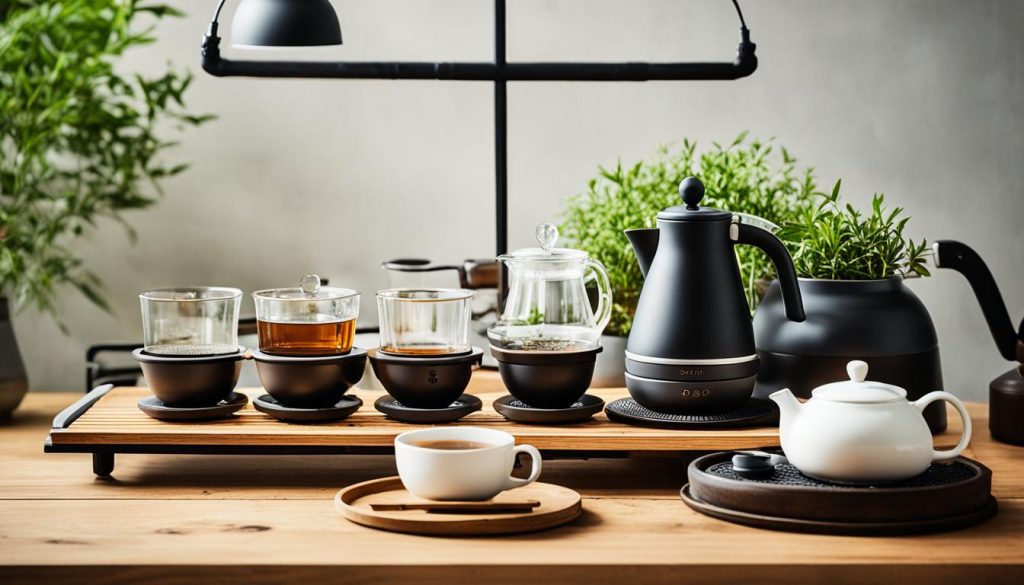
Enhancing Your Tea Brewing Experience
By prioritizing high-quality tea and using appropriate brewing equipment, you can elevate your tea brewing experience to new heights. The combination of superior tea leaves and well-designed tools allows you to unlock the intricate flavors, delicate aromas, and subtle nuances that make each cup of tea unique.
Remember to choose tea that aligns with your taste preferences and explore different brewing styles to discover what best suits your palate. The world of tea offers endless possibilities, and with the right ingredients and equipment, you can embark on a journey of aromatic bliss.
Understanding Steeping Times for Tea
Each type of tea requires a specific steeping time to bring out its optimal flavor. The steeping time can vary depending on personal taste preferences and the type of tea being brewed. Here’s a guide to help you understand the recommended steeping times for different types of tea:
Black Tea
Black tea, known for its bold flavors, is best steeped for 3-5 minutes. This allows enough time for the tea leaves to infuse and release their rich aromas. Adjust the steeping time according to your desired strength.
Green Tea and Matcha
Green tea and matcha have more delicate flavors and require shorter steeping times. For green tea, steep it for 1-3 minutes to preserve its freshness and subtle notes. Matcha, a powdered form of green tea, is whisked in hot water for about 1-2 minutes to create a frothy and vibrant infusion.
White Tea and Oolong Tea
White tea and oolong tea benefit from longer steeping times to unlock their complex flavors. Steep white tea for 4-7 minutes to fully develop its delicate nuances and floral aromas. Oolong tea, with its range of flavors between green and black tea, should be steeped for 4-7 minutes to extract its full character.
Herbal Tea
Herbal teas, such as chamomile or peppermint, can be steeped for a few minutes to extract their flavors and health benefits. Adjust the steeping time based on your taste preference and the intensity of flavors you desire.
Remember, these are general guidelines, and you can always experiment with steeping times to suit your personal preference. Don’t be afraid to adjust the steeping time up or down to achieve the desired flavor intensity. Happy tea brewing!
Conclusion
Mastering the art of brewing aromatic teas requires a deep understanding of the various tea types, their brewing techniques, and the significance of using high-quality tea and brewing equipment. With careful experimentation of steeping times, water temperatures, and personal preferences, tea enthusiasts can create a truly delightful and aromatic tea experience.
Whether you prefer the simplicity of a western-style tea gathering or the refined precision of the traditional Gongfu Cha, the art of tea brewing offers a unique journey that not only connects us to tradition and culture but also allows us to savor the simple pleasures of life.
So, let’s raise our teacups and celebrate the rich tapestry of tea rituals and the countless possibilities tea brewing techniques have to offer. Indulge in the aromatic tea experience, explore new flavors, and discover the joy of embracing tea as more than just a beverage. Cheers to enjoying the perfect cup of tea!
